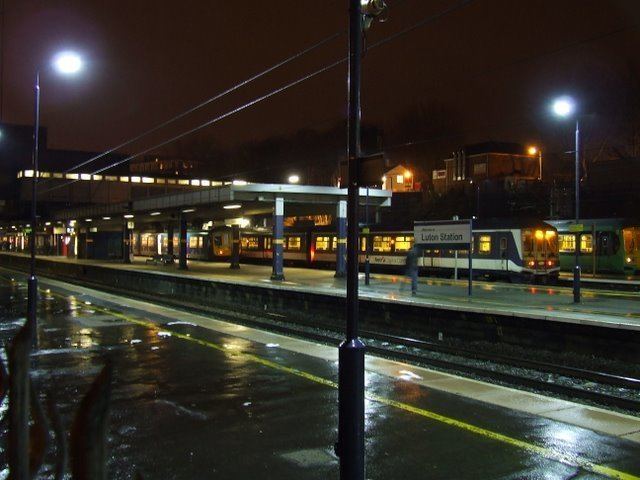Station code LUT DfT category B | Grid reference TL092216 Managed by Thameslink 2011/12 3.440 million Number of platforms 5 | |
 | ||
Luton railway station
Luton railway station is located in Luton, Bedfordshire, England. The station is near to the town centre, about three minutes' walk from the Arndale Shopping Centre. It is situated on the Midland Main Line and is operated by Thameslink.
Contents
- Luton railway station
- Luton railway station in luton town uk with daniel dimitrov
- History
- London Midland and Scottish Railway
- British Rail era
- Privatisation
- Services
- Facilities
- 1955 accident
- 1976 accident
- 7 July 2005 London bombings
- References
Luton railway station in luton town uk with daniel dimitrov
History
It was built by the Midland Railway in 1868 on its extension to St. Pancras. For some years it was known as Luton Midland Road to distinguish it from the earlier Luton Bute Street, built in 1858 on the GNR line from Hertford North to Leighton Buzzard.
To build the line a public area known as the "Great Moor" had to be built through. The remainder of the land was bought for development by John Crawley, who provided a replacement in what is known as the "People's Park." This proved a worthwhile investment because, as the town's staple trade in straw hats diminished as they went out of fashion, it was replaced by engineering works. By the beginning of the twentieth century, the population had nearly trebled and the station had become an important stop for main line expresses.
London, Midland and Scottish Railway
The station, consisting of only 3 platforms was rebuilt in 1937 to the designs of the London, Midland and Scottish Railway company architect William Henry Hamlyn.
British Rail era
In 1960 a fourth platform was added. During electrification in the early 1980s a fifth platform was added for the suburban services to and from St. Pancras.
Privatisation
Upon the opening of Eurostar at St. Pancras International, through-fares to continental Europe were made available from Luton and 67 other UK towns and cities to Paris, Brussels and other destinations in France and Belgium.
The station is set for significant investment from both Network Rail and First Group to improve facilities for customers as well as creating longer platforms as part of the Thameslink Programme. In 2009 the station was identified as one of the ten worst category B interchange stations for mystery shopper assessment of fabric and environment, and is set to receive a share of £50 million funding for improvements. During 2010 and 2011 a number of improvements took place at the station, these included extensions to all five platforms (including removing the barrow crossing) and a new footbridge. The platform extensions form part of the Thameslink Programme and allow 12 car operation at the station. During these works two new rail overbridges were installed over Old Bedford Road allowing the track to be slewed for the extended platforms.
Services
Luton station is served by Thameslink and East Midlands Trains trains. From Luton, trains go north to Bedford, Derby, Melton Mowbray, Corby, Leicester, Nottingham, and Sheffield. Southbound trains go to London, Gatwick Airport, Brighton, Wimbledon and Sutton.
The typical off peak service from this station is as follows:
Thameslink trains serve several stations in Central London, including Farringdon and Blackfriars.
There was previously a shuttle bus service from the station to nearby London Luton Airport. However, this ceased following the construction of Luton Airport Parkway station, though there is the Stagecoach 99 hourly coach service. In September 2013 Arriva launched a new shuttle bus service A with the creation of the Luton and Dunstable Busway which runs from Luton Train Station to London Luton Airport 24 hours a day, also serving Dunstable and Houghton Regis via the new busway
Facilities
Luton station has the following facilities:
1955 accident
On 22 December 1955, two passenger trains collided at Luton station. One passenger was killed, and 23 injured. The first train, a local service from St Pancras to Leicester, had been given the "right-away" from Luton and started to leave the station, but came to a halt when some late passengers attempted to board. As the train was clear of the Home signal, the signalman accepted the second train, an express from St Pancras to Derby. The signals were left at "Danger", so the Derby train should have stopped at the Home signal until the Leicester train had left the station. However, the driver of the Derby train failed to observe the Distant signal, and only made an emergency brake application when he saw the Home signal at danger, from a distance of approximately 400 yards (370 m). He was unable to stop the train in time, and it collided with the stationary Leicester train. The rear two coaches of the Leicester train telescoped into each other, causing the majority of casualties. The official enquiry held the driver of the Derby train responsible for the collision, but also noted that the lights from the nearby Vauxhall factory obscured the view of the Distant signal. The lighting was reorganised following the accident.
1976 accident
A passenger train being operated by a diesel multiple unit overran signals and collided with another diesel multiple unit at Luton South Signal Box. An express passenger train then collided with the wreckage, striking it with a glancing blow.
7 July 2005 London bombings
On the day of the bombings, the four suicide bombers were seen on CCTV entering the station.
